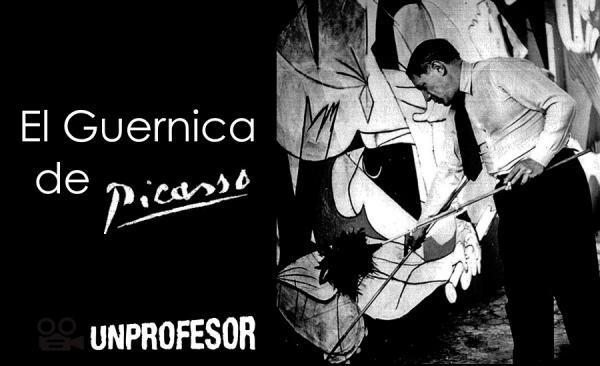Picasso's Guernica - Meaning

In 1937 Pablo Picasso, the best Spanish cubist painter of the 20th century, is commissioned by the republican government to paint a painting for the Paris International Exhibition of 1938, with the sole objective of referring to one of the many catastrophes that occurred during the Spanish Civil War: the bombing of the Basque town of Guernica, razed by the German aviation (Legion Condor) by order of Francisco Franco. Next, in this lesson from a TEACHER, we will discuss the meaning of Picasso's Guernica, a work with which he wanted to pay tribute to all the victims of the town.
Index
- Guernica - Historical context
- Meaning of Pablo Picasso's Guernica
- Character analysis
- Analysis of animals and objects
El Guernica - Historical context.
To know the meaning of Picasso's Guernica it is important that we place ourselves historically in context. You could say that the bombing of the city of Guernica on April 26, 1937 it was really an experiment on the part of the Germans who by order of Francisco Franco they tested the bombs for another of history's great coming catastrophes: World War II World.
Guernica, Basque historical and cultural capital, was thus totally destroyed with hundreds of fatalities, for this reason, Picasso was commissioned to create a work with which to express the pain, the suffering, the violence, the death of this trafficking massacre.
The Andalusian painter accepted this commission by developing an oil painting of more than 7 meters long, which can currently be seen on display in the Reina Sofía Museum of Madrid. As a matter of interest to say that this was the only historical painting that Pablo Picasso painted from the 20th century.
Meaning of Pablo Picasso's Guernica.
We began to talk about the meaning of Picasso's Guernica, dwelling on the details of this work. The painting does not represent the event itself, rather what Pablo Picasso wanted to express with it was the cruelty and violence of the event through the use of images that give rise to a series of interpretations, the best known being that made by Anthony Blunt, a historian of English art that analyzed each and every one of the different characters, animals and objects that appear in the picture.
With this work, Picasso managed to make people have a great impact on the horrors of war, making a plea against fascist aggression, and he did so in a very peculiar way by using few elements, few colors that are reduced to gray, white and black, without any type of relief and with a strong load expressive.
Regarding the light, it is artificial, since neither the light that enters through the window, nor that of the lamp, nor the of the bulb itself produce a rational lighting, it is a light marked by the shapes geometric.
Picasso is the cubist painter par excellence and this painting falls within what is known as synthetic cubism characterized by representing the most significant aspects trying to unite them in a single image.

Analysis of the characters.
To understand the meaning of Picasso's Guernica it is important that we stop at some of the main characters that we can see in this work. They are as follows:
- The woman with the dead child: located just below the bull, it is a symbol of all those who lost their loved ones in the war, in this case, a mother who, looking at the sky and with tears in her eyes, mourns the loss of her child in her hands, symbolizing the pain psychic.
- The warrior: is at the bottom of the painting, on the floor with one of its fragmented spleens holding a broken sword next to a rose that comes to symbolize the hopeful feeling that still continues despite this in war.
- The woman with the lamp: appears with lost gaze absorbed warning us of that sense of tragedy, massacre, extermination ...
- The crippled woman: in the same way it comes to represent the brutality and inhumanity of war, a woman who advances among the dead victims holding one of her injured legs.
- The woman on fire: In the right part of the scene, we see a woman clamoring with her arms to the sky, since she is trapped in a burning building, she is a way of representing physical pain.
Analysis of animals and objects.
Within this painting by Picasso we also find animals, characters that have a strong symbolic charge and that we will analyze below:
- The bull: located on the left side of the scene, it represents the brutality, the bravery to which the Spanish people were subjected in the Spanish Civil War. If we look closely, the bull is the only one who directs his gaze to the public and is not horrified, it is said that it is a self-portrait that Picasso made of himself contemplating this catastrophe.
- Horse: comes to occupy the central part of the scene, and is one of the animals that has generated the greatest controversies on the part of historians in terms of to the true meaning of it, since it has always been considered to be a reflection of the innocent victims who were part of the war, although Picasso in 1945 said that with him he wanted to allude to the “Francoist Spain” interpreted by that horse that appears as maddened and runaway.
- Dove: Barely visible to the viewer since it is painted the same color as the background of the painting, it is distinguished by a white stripe, located between the horse and the bull. It symbolizes the lost peace.
Besides animals, there is also a light bulb in this frame. It is right at the top of the scene, under the head of the horse, and it appears to us as a "sun - light bulb". It comes to represent social progress and scientific and technological advances of the time, advances that could be humanitarian or not, as was the case in this case was the bomb test in the city of Guernica, causing huge destructions.
If you want to read more articles similar to Picasso's Guernica - Meaning, we recommend that you enter our category of Story.



